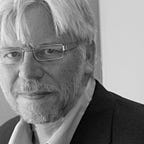Thomas — The really useful technology (with apologies)
Why Assistive Technology is only part of what people with a disability need for access.
If you are a regular reader of features, articles and rants on Medium, you probably believe that words matter. But the words assistive technology are not always well understood, and usually refer to products design specifically for people with a disability. But even if you are not designing products solely for people with a disability, there is a great deal that you can be doing to promote access and inclusion.
Accessible design/Universal Design
These concepts are vital if you want your product or service to reach as large a market as possible. Fundamentally, universal design provides a framework by which you can seek to ensure that you are not building barriers to access into your product. There are seven fundamental principles to Universal design to bear in mind as you develop your product.
· Equitable Use. The design is useful and marketable to people with diverse abilities.
· Flexibility in Use. The design accommodates a wide range of individual preferences and abilities.
· Simple and Intuitive Use. The design is easy to understand, regardless of the user’s experience, knowledge, language skills, or current concentration level.
· Perceptible Information. The design communicates necessary information effectively to the user, regardless of ambient conditions or sensory abilities.
· Tolerance for Error. The design minimizes hazards and the adverse consequences of accidental or unintended actions.
· Low Physical Effort. The design can be used efficiently and comfortably and with a minimum of fatigue.
· Size and Space for Approach and Use. Appropriate size and space is provided for approach, reach, manipulation, and use regardless of user’s body size, posture, or mobility.
Useful Technology
Beyond universal design as a set of principles, innovators can use imagination and creativity to apply their product or service within the context of the barriers and real-world challenges encountered by people with a disability. Crucially, in this case, engaging with people with disabilities will help you find your product’s potential, and in many cases that can be unexpected and potentially profitable. An example of a mainstream product, which has been adopted widely by those with a disability, would be “Grammarly”. Grammarly was developed and marketed to help writers, including students, review and improve their written work by building upon simple spell checking to include grammar, style and ease of reading. Initially, the tool helped authors make sure that those with print impairments such as Dyslexia could readily understand the text, and it was then adopted by those with Dyslexia themselves as a low-cost means of reviewing their written work and ensuring that errors were reduced. As a result, their confidence in their wring increased.
Useful technology is essential; it tends to be mass-market technology and hence is much cheaper than solutions designed to address the needs of those with specific needs. Products such as Uber led the way in allowing deaf people to access services without speaking to an operator. Similar technologies are now used for an extensive range of delivery services and have been vital in helping people with disability access essential goods during the Covid pandemic.
Summary
Supporting people with a disability and increasing your market does not need to be complicated. As we innovate and design, being conscious and aware of the needs of potential customers lets us think carefully about the depth and breadth we would like to achieve. Asking three simple questions can help us pitch our design to be both inclusive and profitable.
1 Does my product have features of functions that people with disabilities might find helpful?
2 If I design my product with Universal Design in mind, can I reach those people more effectively?
3 If I add or integrate assistive tools, can I serve those customers in new ways, reaching more people and adding market share?
Successfully responding to these questions can be a win/win situation — developers increase sales, and those with disabilities get products they value.
